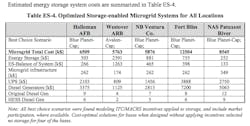Integrating energy storage into microgrids can improve reliability and reduce costs on military bases that can take advantage of wholesale power markets and tax incentives, according to a report written for the US Department of Defense.
The study — Design, Modeling, and Control of Hybrid Energy Storage System for Defense Installation Microgrids — explored the value of adding different types of energy storage to five existing microgrids.
The microgrids ranged in size and scope. They were at the Westover Air Reserve Base near Springfield, Massachusetts; the Naval Base Ventura County in Port Hueneme, California; the Holloman Air Force Base near Alamogordo, New Mexico; Naval Air Station Patuxent River near Lexington Park, Maryland; and, the U.S. Army’s Fort Bliss in El Paso, Texas.
The study used modeling to see how the microgrids would be affected by various energy storage technologies including ultracapacitor, lithium ion, lithium iron phosphate, zinc hybrid cathode, sodium sulfur, and flow battery technologies.
Three main issues affect economic performance of the microgrids with energy storage: microgrid cost, available on-site photovoltaic generation, and local utility wholesale market participation and ancillary service revenues, according to the study.
The economics of the projects can improve significantly by optimizing the microgrid, with a focus on size and integration of photovoltaic generation, according to the report.
Adding energy storage to sites with little renewable generation, limited market participation options, and no ability to use incentives such as federal investment tax credits and federal Modified Accelerated Cost-Recovery System, provides at best limited economic benefits, the researchers found.
However, where there are incentives for energy storage microgrids can: improve energy security over day-long and 168-hour outages while making it possible to meet more than 100 percent of critical load without resizing the system.
Researchers also said that where incentives are available, integrating energy storage into microgrids reduced fuel use during seven-day outages by up to 22%.
Energy storage can also “integrate on-grid economic optimization with off-grid reliability to provide resilience with potential rapid return on investment at sites with significant market participation potential,” the researchers said.
Source: US Dept. of Defense report Design, Modeling, and Control of Hybrid Energy Storage System for Defense Installation Microgrids
The report found little difference in the performance or economic effects of the different storage technologies that were studied.
Lithium iron phosphate storage proved optimal storage at four military bases because of its high lifetime and low self-discharge rate. A flow battery was identified as the best for the Westover base for the same reasons, researchers said.
“However, other technologies also show promise with nearly equivalent economic performance,” the report said.
The study was conducted by Southern Research, in collaboration with Arizona State University, XENDEE and 350Solutions, under a contract with the DoD’s Environmental Security Technology Certification Program.
Read more about integrating energy storage into microgrids.







